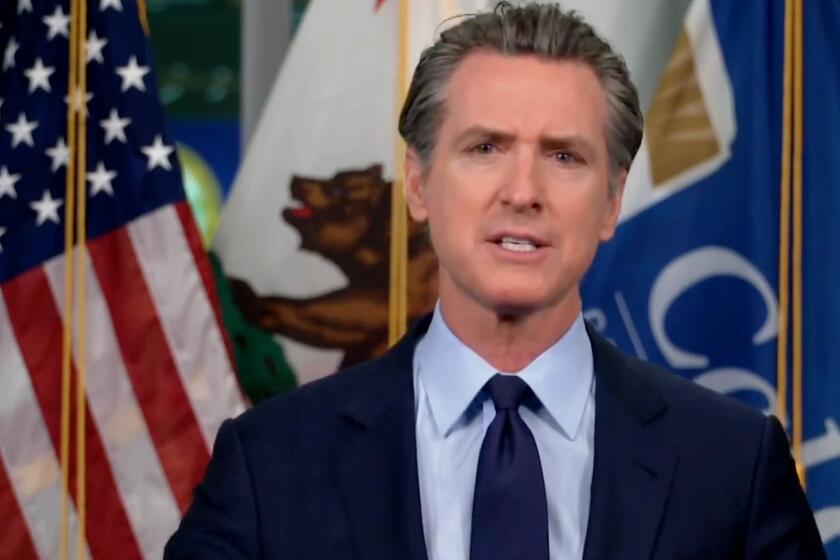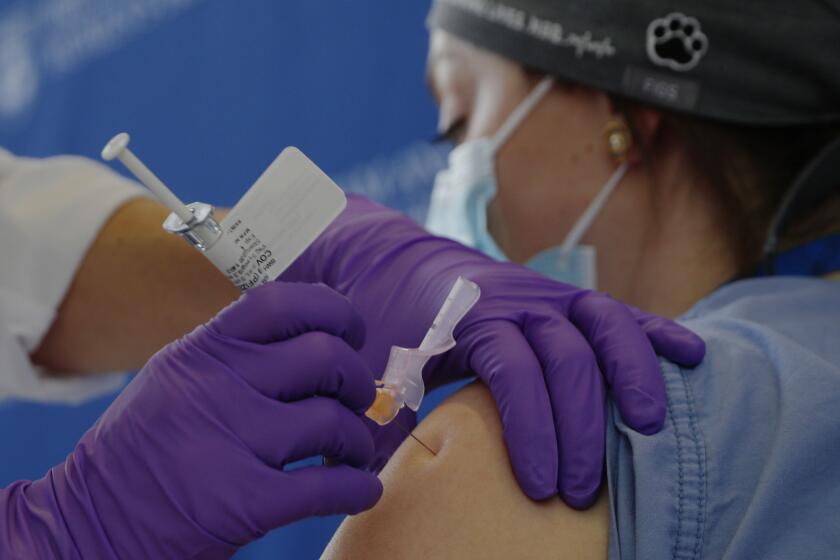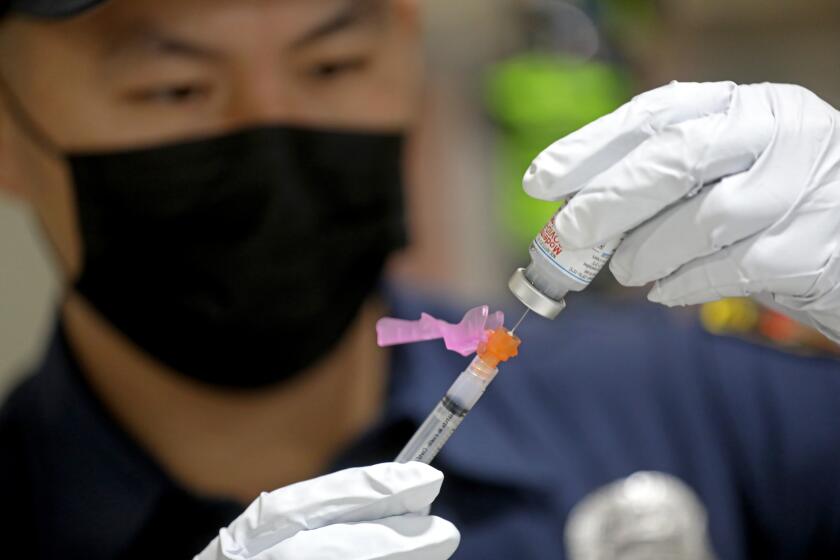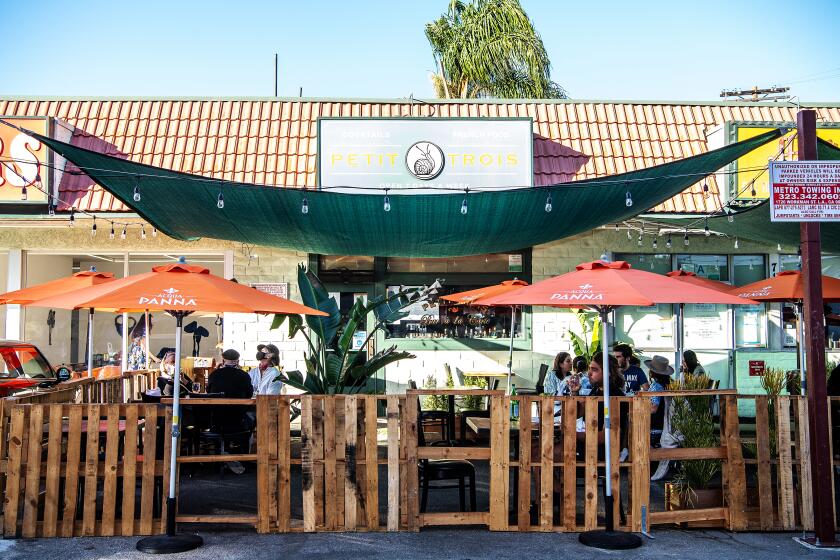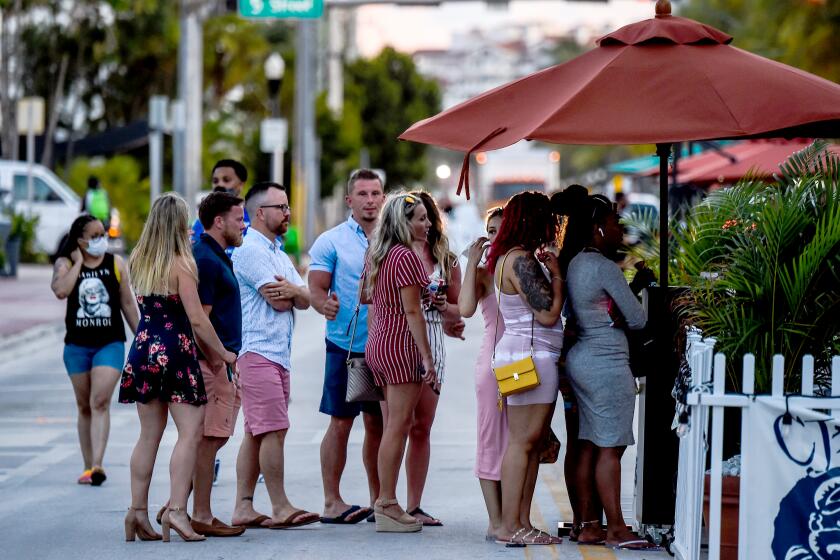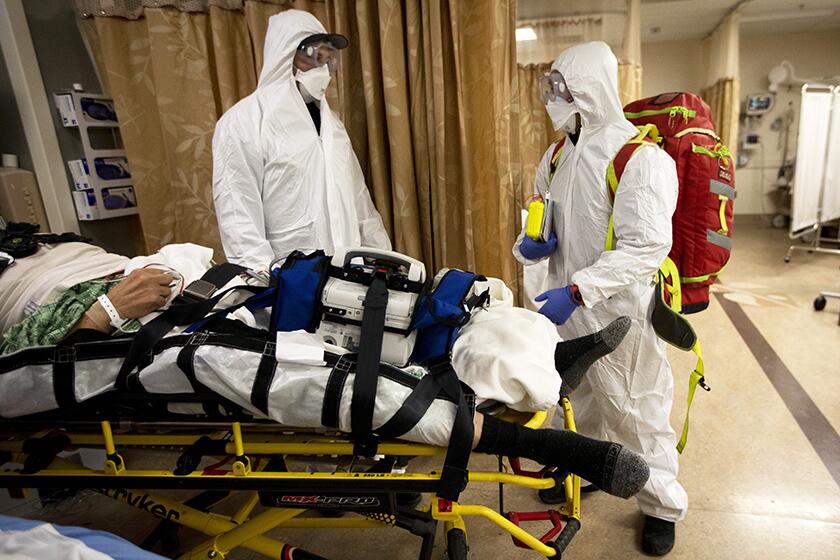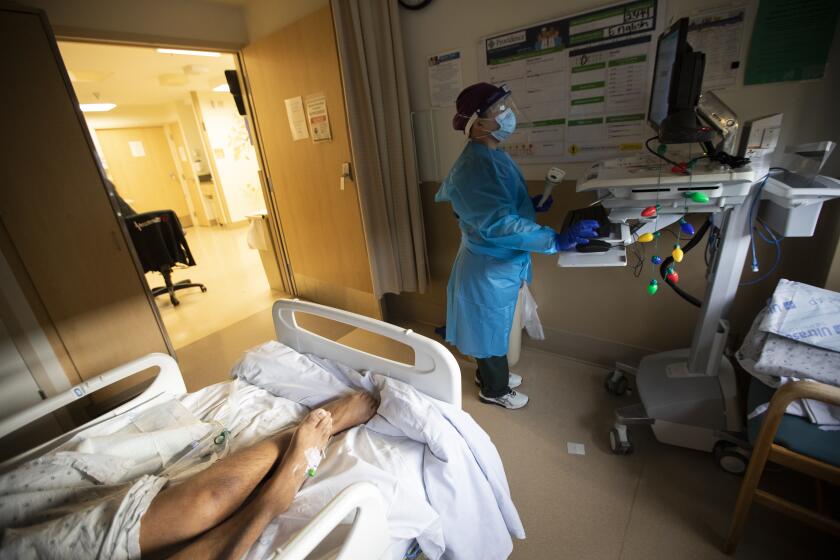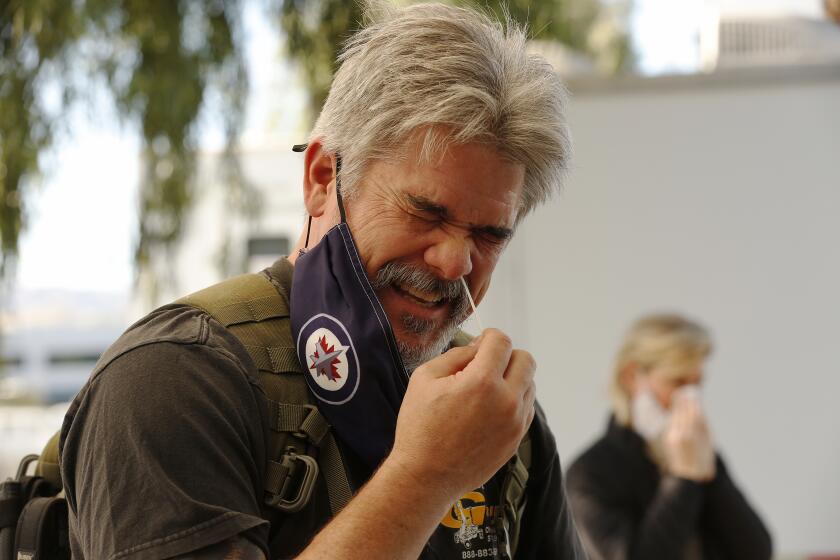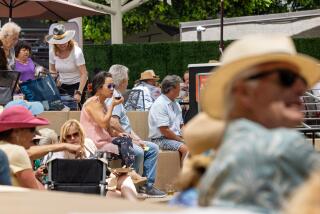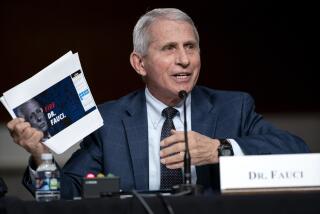Fauci’s 2021 COVID California forecast: School reopenings, vaccines and some normalcy by fall
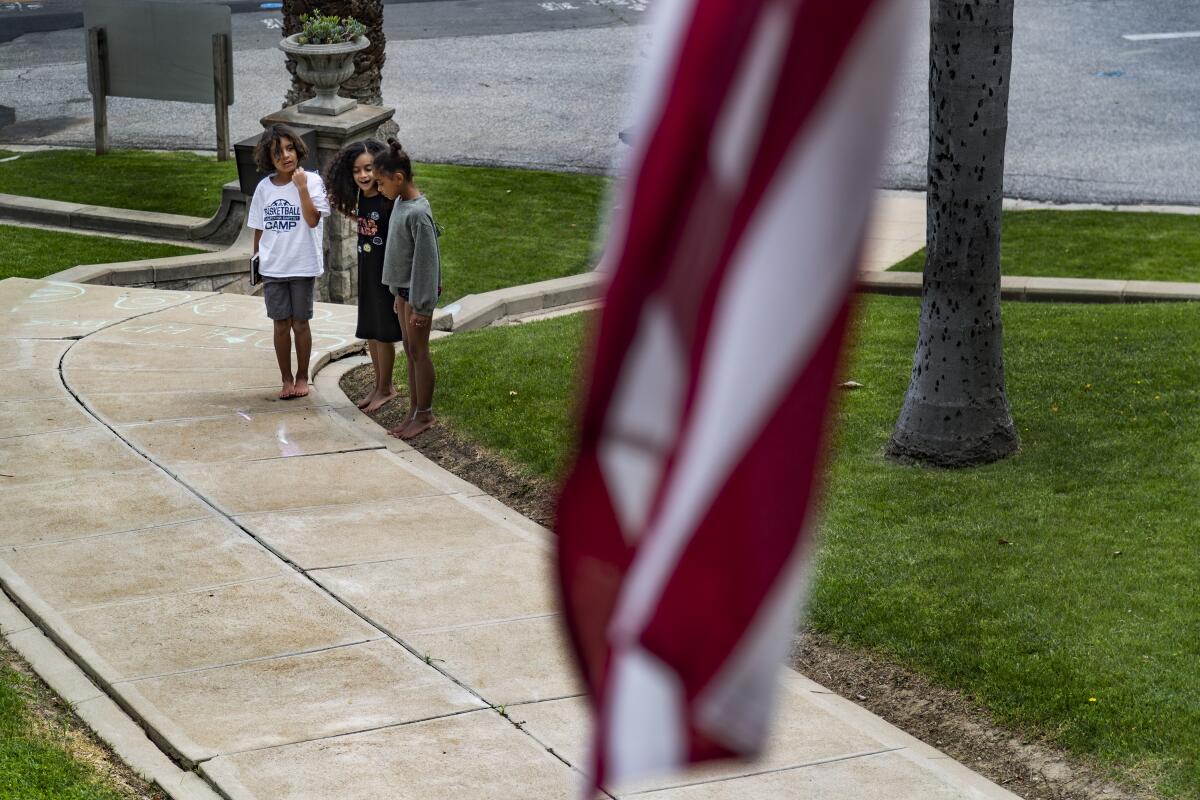
- Share via
It’s been a grim December, and January is looking to be just as bleak as the coronavirus continues to ravage both California and the nation.
In a conversation broadcast online Wednesday, Dr. Anthony Fauci, the U.S. government’s top infectious diseases expert, talked to Gov. Gavin Newsom about why the pandemic has been so hard to control in California and across the U.S.
But he also offered some hope for the future, outlining his latest estimate on when things might get back to a semblance of normality and whether schools can reopen safely.
Here are some of Fauci’s thoughts on what 2021 might look like:
California students in kindergarten through second grade would be allowed back on campus when pandemic conditions improved under a proposal announced Wednesday.
Schools can safely reopen, even when there’s substantial community transmission
Fauci said the coronavirus acts very differently from the flu when it comes to children.
With the coronavirus, children seem to have lower levels of infection than the broader community.
“That was almost counterintuitive, but it’s turning out to be that way,” Fauci said.
“What we should do is to do everything to support the maintenance of the children in school. ... If you really want to get society back to some form of normality, one of the first things we have to do is to get the children back in school.”
Americans waiting their turn for a COVID-19 vaccine may not be pleased to see who’s in line ahead of them. Does a prisoner or smoker deserve it more?
Vaccines for broader public to be distributed in late spring, early summer
Initial distribution of the vaccine to the top priority group, including healthcare workers and people in nursing homes, has been slower than initially promised. But Fauci said there’s a sense that by January, there will be greater momentum and that the pace of inoculations will accelerate.
Before the general public receives the vaccine, though, there are other priority groups who are next in line. It will probably be the end of March or the beginning of April before the vaccine is available to everyone.
At that point, the race will be on to get as many people vaccinated through the spring and summer, with the goal to have everyone vaccinated by the time cooler weather arrives next fall.
Americans’s interest in a COVID-19 vaccine is waning, with only 56% of adults saying they would get it if it were available. That’s down from 74% in April.
‘Strong semblance of normality’ by early autumn — if enough people get vaccinated
If the U.S. is diligent about getting many people vaccinated between April and July, “I believe ... by the time we get to the early fall, we will have enough good herd immunity to be able to really get back to some strong semblance of normality — schools, theaters, sports events, restaurants. I believe if we do it correctly, we will be there by the early fall,” Fauci said.
No one really knows what percentage of the population needs to be immunized to interrupt the spread of the virus, Fauci said. He guessed it would be somewhere between 70% and 85%.
“If you have the opportunity to get vaccinated, please get vaccinated,” Fauci said. “It’s a safe and it’s a highly efficacious vaccine that could save your life, the life of your family and the community.
“So I believe with those two things — adherence to the kind of things that you’ve been talking about in California, the public health measures, and as we gradually get more and more people vaccinated, we’re going to be looking at this thing in the rearview mirror,” Fauci told Newsom.
California’s economic recovery slowed in November as lots of workers dropped out of the labor force. Unemployment, which counts those still seeking work, fell to 8.2%.
Failure to contain coronavirus would be disastrous for economy
Some people think of the business restrictions implemented to control the pandemic as too high a price to pay. But Fauci said the pandemic needs to be controlled in order to allow the economy to get back to normal.
“We need to use public health measures — as a vehicle, a gateway, a tool — to get the economy back. It isn’t the economy versus public health. It’s public health bridging you to getting the economy back,” Fauci said.
The economy will reopen “when you get the level of infection down,” Fauci said. “And the only way you’re going to get the level of infection down before the vaccine kicks in is by the public health measures that you have been talking about.”
Why has the U.S. done so much worse than Europe in controlling the coronavirus? Preferring medical miracles, Americans reject simple public health steps.
Fauci also looked back at the challenges of 2020. Here are some key points:
Asymptomatic spread of the virus makes this pandemic far harder to control
The initial information coming out of China in late 2019 about the coronavirus was misleading, Fauci said.
Initially, the word was that the virus did not efficiently transmit between humans, which ended up being wrong. Then, the word was that it was mostly being transmitted by people who were visibly sick.
The sobering reality was that even people without visible symptoms were transmitting the virus.
“That, to me, is something that was the game-changer,” Fauci said. “Because you can’t just test people who are with symptoms, because you’re going to miss the asymptomatic people.”
Second, it meant that mask wearing became very important. “If you don’t know who’s infected, then everybody should be wearing a mask, which is the real fundamental rationale for saying we need universal and uniform wearing of masks,” Fauci said.
L.A. County hospitals hit breaking point: ‘No one would believe this is in the United States’
Wide range of outcomes — from no symptoms to death — made it too easy to dismiss the virus
Fauci said he’s never seen a virus like this one, where 40% of those infected have no symptoms at all, while 20% to 25% get symptoms so severe they may need hospitalization or die.
“The mystery of how you can have so many people who have no symptoms, and so many people who get seriously impacted, is one of the reasons why we have a messaging difficulty,” Fauci said. “Because most of the people who do well are young people, and they say, ‘What do I got to worry about?’ ... So they say to themselves, ‘Why do I need to interrupt my life?’ ”
But that sentiment has had serious consequences and has been a factor in the worst death toll of any nation in the world — more than 335,000 deaths. And public health activities such as mask wearing became politicized.
In Los Angeles County, the cumulative COVID-19 death toll of more than 10,000 is now triple the cumulative death toll from the flu in the last flu season, which was 3,133.
Doubts about the vaccine among healthcare workers could have serious implications for public health, say experts.
This has been the most politicized public health crisis in modern U.S. history
The best public health messages are consistent and simple. But the COVID-19 pandemic has become so politically divisive that it’s been very difficult to have a consistent public health message, Fauci said.
It has even been worse than the efforts to raise awareness of HIV and AIDS, public health crises that political leaders failed to pay enough attention to in their early years. “It wasn’t anything like the divisiveness that we’re seeing right now, which really makes implementation of public health measures and public health messaging very difficult,” Fauci said.
U.S. should have done much better in controlling the pandemic
Asked by Newsom whether he expected the U.S. would be dealing with a national death toll exceeding 335,000, Fauci admitted he had thought the U.S. would be in a much better place by now.
Even when New York was being hit hard in the late winter and early spring of 2020, Fauci expected that the nation would push coronavirus levels down and that public health officials would figure out how to contain flare-ups.
But the U.S. never got to a low baseline, Fauci said. Too many states abandoned stay-at-home orders too early, so when the cooler weather came with the arrival of fall, “we just went right off the roof,” Fauci said.
“What surprised me and really disappointed me so much was that I thought if we would get down to a really, really low baseline, as we had these individual little blips, we could do identification, isolation and contact tracing, and we’d be in good shape,” Fauci said.
“The only trouble is, when you have ... 100,000 community cases on a given day, it makes it almost impossible to do effective identification, isolation and contact tracing,” he said. “So we’ve been hit badly, and unfortunately, California is hit right now currently as bad as anybody, if not worse.”
The home-testing pilot program for L.A. County residents runs through Jan. 15 and is designed to reduce COVID-19 spread through the holidays.
We should be doing even more testing
As we look ahead, Fauci said we should be looking at flooding schools and congregate living settings with testing, particularly with so-called antigen tests that are easier to process and can be used widely in settings such as schools.
“If we just very, very much utilize that testing — in schools for teachers, even ultimately, for the students, intermittently — you could get a good feel for what the penetrance of infection is and you can do something about it,” Fauci said.
“We should put much more emphasis on community-type of surveillance testing, so that you get a feel for where you are — where you are with schools, with prisons, with nursing homes. That’s the way to go,” Fauci said. Because the virus is often transmitted by people with no signs of illness, “you’re not going to get them by only testing people with symptoms.”
Colleges that have implemented this kind of routine testing have found this approach successful in maintaining a low level of virus transmission, he said. That’s because this approach identifies virus-positive people early and sends them into isolation until they recover, rather than allowing the virus to become so widespread that officials are forced to shut the campus down.
More to Read
Sign up for Essential California
The most important California stories and recommendations in your inbox every morning.
You may occasionally receive promotional content from the Los Angeles Times.
